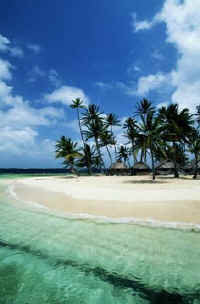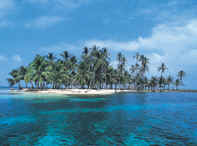The guide books told us that Wichub Huala was the only place nearby with a store, and we needed some provisions. The island was just across from Porvenir, so we raised anchor, plotted a course through the shallows and coral heads, and slowly headed that way. As we got closer to the island we could see a local boat unloading some supplies on a long concrete dock and we decided that must be the "tienda" or market. We motored Stray Cat close to the dock before anchoring and the local school children, who must've been on a break from school, were out on the dock waving to us as we prepared to enter the island by dinghy.
The five of us loaded into the dinghy for a grocery trip, motored the short distance over to Whichub Huala, pulled in next to the dock and tied off the dinghy. The island was very primitive for the most part, with the majority of the houses and buildings begin bamboo huts. Most of the younger people were dressed as Americans would be and the older women or mothers were wearing the traditional dress, which consisted of a red and yellow bandana or scarf on the head, a floral print shirt on the top and a "Mola" sewn in to the middle with a long navy printed sarong and bracelets on the wrists and covering their legs, from the ankles to the knees. They were gorgeous. Molas, the local traditional craft, are hand made colorful appliqus sewn into many different layers of cloth, almost like an incredibly intricate needlepoint, that is layered with very colorful & unique designs and in most cases animals, flowers or geometric shapes.
We headed straight into the market and found a good supply of items - plantains, beers, sodas, canned veggies, pineapple, cereal, & even peanut M&M's! They also had some nice ballcaps for $2.50 ea. The young Kunas who were managing the store were very nice and helpful, and we were all impressed by their professionalism. After we had purchased our supplies, we headed out into the village for some bread and rum, two things that were not available at the store. The island was built in a very traditional way - bamboo huts were used for almost every home & also for the "congreso", the large gathering place for the nightly tribal meetings. There were only a few buildings that weren't made from bamboo and thatch, and those were the school and the clinic.
We made our way through the dirt streets or paths between the homes, and immediately noticed tables set up with women selling their wares. It was strange to see tables like at a craft show every 15 feet. They knew we were coming! We found out that occasionally Cruise Ships will pull into Porvenir, so that is why many locals had tables to set up for vending. At every table there were Molas, bracelets, jewelry, purses, pot holders, shells, and small flutes made from a local seed. We bought a few things on our way to the bakery. The "bakery" that we found was actually a person's home - a bamboo hut - and we were fairly certain that the bread was made over a fire, although we did not get to see it being made. We purchased what looked like bread sticks for 10 cents each - we now know that that is the only kind of bread you will find in Kuna Yala. Next, we weaved through the huts and craft tables and came to a small store where they did have one kind of rum, Ron Abuelo Anejo, which we tasted before buying, and it was good enough! That was our last purchase on Wichub Huala.
We also had some interesting conversations with a few locals about the "Cayucos" - they told us how men traveled to the mountains on an expedition to find a huge tree to make their boats. It would take many men a very long time to find the right tree and even longer to get it back down to the island from the mountains. The boats were incredible and beautifully - each crafted from a single gargantuan tree.
We bid farewell to the wonderful people and took all of our supplies and souvenirs out to Stray Cat. Our next stop would be the Eastern Holandes Cays.
Tuesday, October 30, 2007
Subscribe to:
Post Comments (Atom)


No comments:
Post a Comment